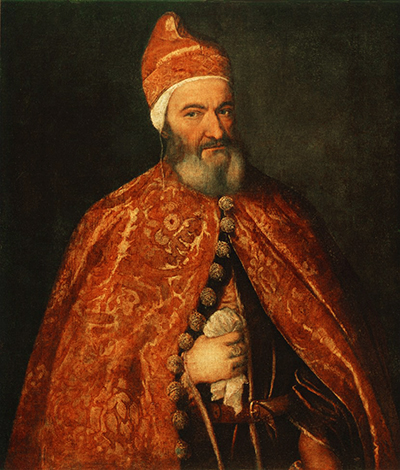As a precursor of the Italian Renaissance, Titian integrates an increased dramatic expression in his paintings.
Despite the static composition of the Portrait of Doge Marcantonio Trevisani, Titian demonstrated the great potential of using smooth and fluid brush strokes to capture light. By combining thick and thin layers, he created a textured and tactile surface which brings the portrait to life.
Marcantonio Trevisani was the 80th doge of Venice, famous for religious fanaticism. During his brief ruling, he tried to restrict celebrations and feasts in favor of spirituality and union with the Divine dictates. However, he became isolated because the people of Venice never followed his beliefs. Titian executed the painting to be displayed in the Sala del Maggior Consiglio in the doge's residence. It's one of the series of portraits created by Titian which were all burnt in 1577. The master made several versions of the portrait and one of them is displayed in the Budapest Museum of Fine Arts. It's a common belief that this painting is the official portrait of Titian.
Titian used broad and smooth brush strokes to fully reflect the natural fluidity of the portrait's expression. He uses oil paint to create a tactile and texturized painting and enhance its expressive power. What the portrait lacks in details, it makes up for in the dynamics of the brushwork. Through loose and versatile strokes, Titian manages to incorporate spontaneity in the painting. His technique attests the highly creative potential of oils which create a breath-taking depth of the painting.
Whenever Titian executed a painting, he always carefully considered the display location and how light would reflect off it to fully express the vitality of his works. His attention to detail is proven by the features of the doge's garment which illustrates a play of light and shadows. Titian also uses an interplay of dark and light to capture the facial characteristics of the doge, describing his powerful and deep personality. Although the portrait doesn't include a wide range of colours, incredible dynamics are created by alternating waves of tones. The Portrait of Marcantonio Trevisani has a size of 100 x 86.5 cm and is executed with oil on canvas. The painting is currently displayed at the Museum of Fine Arts in Budapest.
Unlike his fellow Venetian painters, Titian was committed to articulate and prove the mastery of oil paintings in creating dynamic effects in static portraits. The Portrait of Marcantonio Trevisani stands at the forefront of Titians' use of smooth and wide stroke techniques to capture the depth of the character. Read more in this Titian biography.




